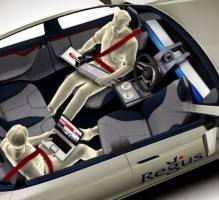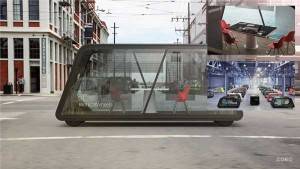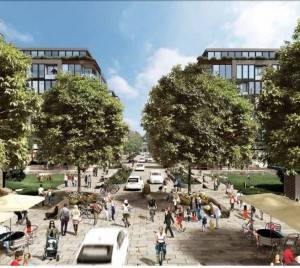 Game changing technology doesn’t come any more disruptive than driverless vehicles. The problem is that we may find the whole idea easy to dismiss based on our past experiences of this sort of thing. Autonomous vehicles carry the whiff of Tomorrow’s World about them, yet they are about to go mainstream far sooner than we might think and their advent will have a major impact on the way we work and live. Both Ford and BMW have announced they intend to have fully autonomous vehicles on the roads within five years. That doesn’t mean the test models that are already on the roads but commercially available vehicles; Volvo will have 100 customers in Sweden and the UK using the vehicles next year. Tesla claims its cars will be driverless in two years. And it’s not just car makers who are intent on grabbing a share of this new market but computer makers like Google and Apple as well as sharing economy pioneers like Uber.
Game changing technology doesn’t come any more disruptive than driverless vehicles. The problem is that we may find the whole idea easy to dismiss based on our past experiences of this sort of thing. Autonomous vehicles carry the whiff of Tomorrow’s World about them, yet they are about to go mainstream far sooner than we might think and their advent will have a major impact on the way we work and live. Both Ford and BMW have announced they intend to have fully autonomous vehicles on the roads within five years. That doesn’t mean the test models that are already on the roads but commercially available vehicles; Volvo will have 100 customers in Sweden and the UK using the vehicles next year. Tesla claims its cars will be driverless in two years. And it’s not just car makers who are intent on grabbing a share of this new market but computer makers like Google and Apple as well as sharing economy pioneers like Uber.
Earlier this month, BMW CEO Harald Krueger BMW announced at the company’s annual shareholder meeting in Munich that it would have driverless vehicles commercially available within five years. “In 2018, we will launch a BMW i8 Roadster”, he told shareholders. “This will be followed in 2021 by the BMW i Next, our new innovation driver, with autonomous driving, digital connectivity, intelligent lightweight design, a totally new interior and ultimately bringing the next generation of electro-mobility to the road. Our goal is already clearly-defined – to be number one in autonomous driving”, he said, arguing that “vehicle safety and the security of our customers’ personal data” is a “top priority” for BMW and “something that distinguishes us from other providers.”
A similar timeline was the subject of a Ted Talk delivered by Google’s Chris Urmson last year. [embedplusvideo height=”283″ width=”450″ editlink=”https://bit.ly/1qt8cK1″ standard=”https://www.youtube.com/v/tiwVMrTLUWg?fs=1″ vars=”ytid=tiwVMrTLUWg&width=450&height=283&start=&stop=&rs=w&hd=0&autoplay=0&react=1&chapters=¬es=” id=”ep8840″ /]
Economic transformation
Earlier this year, we reported on the impact that driverless vehicles will have on the economy. A study by KPMG claims that by 2030, the advent of autonomous vehicles will have created 320,000 new jobs in the UK and boosted the economy by around £51 billion per annum as well as reducing congestion, carbon emissions and road deaths. This has brought the technology to the attention of the Government who announced in 2015 that it was investing around £100 million in the technology to ensure the UK stays at the forefront of developments. More details of the Government’s plans for driverless cars are set out in today’s Queen’s Speech.
It’s not good news for everybody, of course. Many commercial drivers and people working in related jobs may find their livelihood under threat. Other concerns exist around car makers as some pundits believe car ownership could fall dramatically as a result of vastly more car sharing. The problem with such forecasts is that they are based on many unknown factors, including the challenge of people accepting driverless vehicles, and are not linear to begin with. For example, while the number of cars may fall, those that remain may be used more, including by a large number of people currently unable to drive. So cars may need to be replaced more frequently. A study by the University of Michigan’s Transportation Research Institute claims that automated vehicles might reduce vehicle ownership by 43 per cent, but that average vehicle mileage would double.
The car becomes an office
It has been estimated that the average car spends around 90 percent of its time parked. Driverless cars allow us to look at a new model of sharing in which cars take on more of the characteristics of public transport. A recent study in Singapore carried out by researchers from MIT found that fewer than 30 per cent of the vehicles currently used in the city would be required if fully automated car sharing could be implemented.
 This, in turn could make it easier for firms to organise car sharing programmes for co-workers and will certainly change the design of cars to become places of work as well as reducing the terrors of the daily commute. This is prompting design leaders like IDEO to explore ideas about the changing face of mobility. The firm has introduced an initiative called automobility which looks at these new ideas and what they will mean for the design of vehicles, although whether people will welcome the transparent work pods that they have envisaged is another matter. Doubtless this will involve the integration of other technological elements to the vehicles to make them full functioning workplaces. If we can get back to the idea of a constrained working day, this will have the potential to make people more productive and do away with the grind of the commute.
This, in turn could make it easier for firms to organise car sharing programmes for co-workers and will certainly change the design of cars to become places of work as well as reducing the terrors of the daily commute. This is prompting design leaders like IDEO to explore ideas about the changing face of mobility. The firm has introduced an initiative called automobility which looks at these new ideas and what they will mean for the design of vehicles, although whether people will welcome the transparent work pods that they have envisaged is another matter. Doubtless this will involve the integration of other technological elements to the vehicles to make them full functioning workplaces. If we can get back to the idea of a constrained working day, this will have the potential to make people more productive and do away with the grind of the commute.
Internet of Things based tech such as interactive screens, intelligent work tables, speech-enabled devices and so on could support a new generation of road warriors. Physical features such as swivelling chairs would allow the car to become a meeting space. The car becomes the office in just the same way that Apple and Facebook’s fleet of buses already function as offices for staff on their way into work.
Microsoft is already on board with the idea. At the recent Consumer Electronics Show in Las Vegas, it announced that it would be deploying Office 365 in cars with bespoke as well as standard features. This will predate the era of driverless vehicles but the firm is obviously playing the long game by integrating its systems, including Skype and automated personal assistants, into cars.
Perhaps unsurprisingly, Regus is also looking to get in on the act. It is working in a long term partnership with automotive industry think tank Rinspeed to create a driverless vehicle that works as a meeting space for four people (main image).
The effect on corporate real estate
 It’s not just working practices that could be set to change. A report published last month by WSP and Farrells claimed to identify exactly how the advent of autonomous vehicles would have a significant impact on the real estate sector worldwide. It suggests that changes in the way cars are owned and used will free up large tracts of potentially valuable property for other uses. Although the report confirms that driverless cars may increase the amount of people able to use cars for transport, including those currently unable or unwilling to drive, the amount of parking necessary to accommodate them may shrink significantly as shared ownership becomes a norm and road design changes to meet the needs of autonomous vehicles. The end result will be significant changes in the way urban space is planned and developed with a potential increase in the amount of land available for development by up to a fifth. IN the UK this will equate to hundreds of millions of pounds of added value for major city centres.
It’s not just working practices that could be set to change. A report published last month by WSP and Farrells claimed to identify exactly how the advent of autonomous vehicles would have a significant impact on the real estate sector worldwide. It suggests that changes in the way cars are owned and used will free up large tracts of potentially valuable property for other uses. Although the report confirms that driverless cars may increase the amount of people able to use cars for transport, including those currently unable or unwilling to drive, the amount of parking necessary to accommodate them may shrink significantly as shared ownership becomes a norm and road design changes to meet the needs of autonomous vehicles. The end result will be significant changes in the way urban space is planned and developed with a potential increase in the amount of land available for development by up to a fifth. IN the UK this will equate to hundreds of millions of pounds of added value for major city centres.
According to the report’s authors: “As AVs can move while empty, they can therefore offer door-to-door journeys to match individual needs exactly without needing a parking space at either end of that trip. This is critical to the potential for better placemaking. With reference to the latest DCLG figures [for the UK], a 100 hectare AV zone development in the heart of London could gain more than £1.25 billion in additional land value uplift as a direct result, or £300m in outer London or £15-£75m across much of the rest of the country.”














May 18, 2016
What the imminent arrival of driverless vehicles will mean for the way we work 0
by Mark Eltringham • Cities, Comment, Flexible working, Technology
Earlier this month, BMW CEO Harald Krueger BMW announced at the company’s annual shareholder meeting in Munich that it would have driverless vehicles commercially available within five years. “In 2018, we will launch a BMW i8 Roadster”, he told shareholders. “This will be followed in 2021 by the BMW i Next, our new innovation driver, with autonomous driving, digital connectivity, intelligent lightweight design, a totally new interior and ultimately bringing the next generation of electro-mobility to the road. Our goal is already clearly-defined – to be number one in autonomous driving”, he said, arguing that “vehicle safety and the security of our customers’ personal data” is a “top priority” for BMW and “something that distinguishes us from other providers.”
A similar timeline was the subject of a Ted Talk delivered by Google’s Chris Urmson last year. [embedplusvideo height=”283″ width=”450″ editlink=”https://bit.ly/1qt8cK1″ standard=”https://www.youtube.com/v/tiwVMrTLUWg?fs=1″ vars=”ytid=tiwVMrTLUWg&width=450&height=283&start=&stop=&rs=w&hd=0&autoplay=0&react=1&chapters=¬es=” id=”ep8840″ /]
Economic transformation
Earlier this year, we reported on the impact that driverless vehicles will have on the economy. A study by KPMG claims that by 2030, the advent of autonomous vehicles will have created 320,000 new jobs in the UK and boosted the economy by around £51 billion per annum as well as reducing congestion, carbon emissions and road deaths. This has brought the technology to the attention of the Government who announced in 2015 that it was investing around £100 million in the technology to ensure the UK stays at the forefront of developments. More details of the Government’s plans for driverless cars are set out in today’s Queen’s Speech.
It’s not good news for everybody, of course. Many commercial drivers and people working in related jobs may find their livelihood under threat. Other concerns exist around car makers as some pundits believe car ownership could fall dramatically as a result of vastly more car sharing. The problem with such forecasts is that they are based on many unknown factors, including the challenge of people accepting driverless vehicles, and are not linear to begin with. For example, while the number of cars may fall, those that remain may be used more, including by a large number of people currently unable to drive. So cars may need to be replaced more frequently. A study by the University of Michigan’s Transportation Research Institute claims that automated vehicles might reduce vehicle ownership by 43 per cent, but that average vehicle mileage would double.
The car becomes an office
It has been estimated that the average car spends around 90 percent of its time parked. Driverless cars allow us to look at a new model of sharing in which cars take on more of the characteristics of public transport. A recent study in Singapore carried out by researchers from MIT found that fewer than 30 per cent of the vehicles currently used in the city would be required if fully automated car sharing could be implemented.
Internet of Things based tech such as interactive screens, intelligent work tables, speech-enabled devices and so on could support a new generation of road warriors. Physical features such as swivelling chairs would allow the car to become a meeting space. The car becomes the office in just the same way that Apple and Facebook’s fleet of buses already function as offices for staff on their way into work.
Microsoft is already on board with the idea. At the recent Consumer Electronics Show in Las Vegas, it announced that it would be deploying Office 365 in cars with bespoke as well as standard features. This will predate the era of driverless vehicles but the firm is obviously playing the long game by integrating its systems, including Skype and automated personal assistants, into cars.
Perhaps unsurprisingly, Regus is also looking to get in on the act. It is working in a long term partnership with automotive industry think tank Rinspeed to create a driverless vehicle that works as a meeting space for four people (main image).
The effect on corporate real estate
According to the report’s authors: “As AVs can move while empty, they can therefore offer door-to-door journeys to match individual needs exactly without needing a parking space at either end of that trip. This is critical to the potential for better placemaking. With reference to the latest DCLG figures [for the UK], a 100 hectare AV zone development in the heart of London could gain more than £1.25 billion in additional land value uplift as a direct result, or £300m in outer London or £15-£75m across much of the rest of the country.”